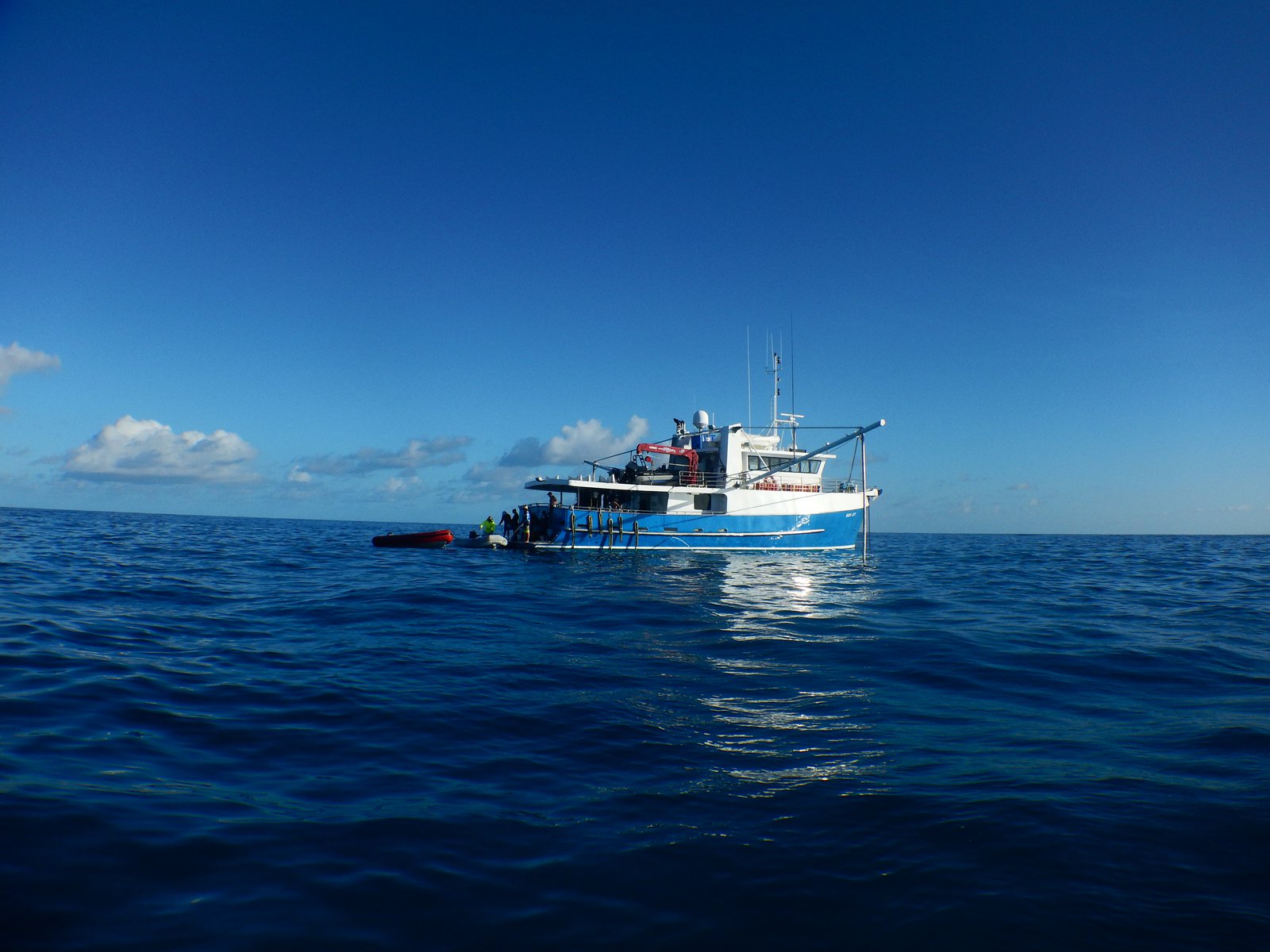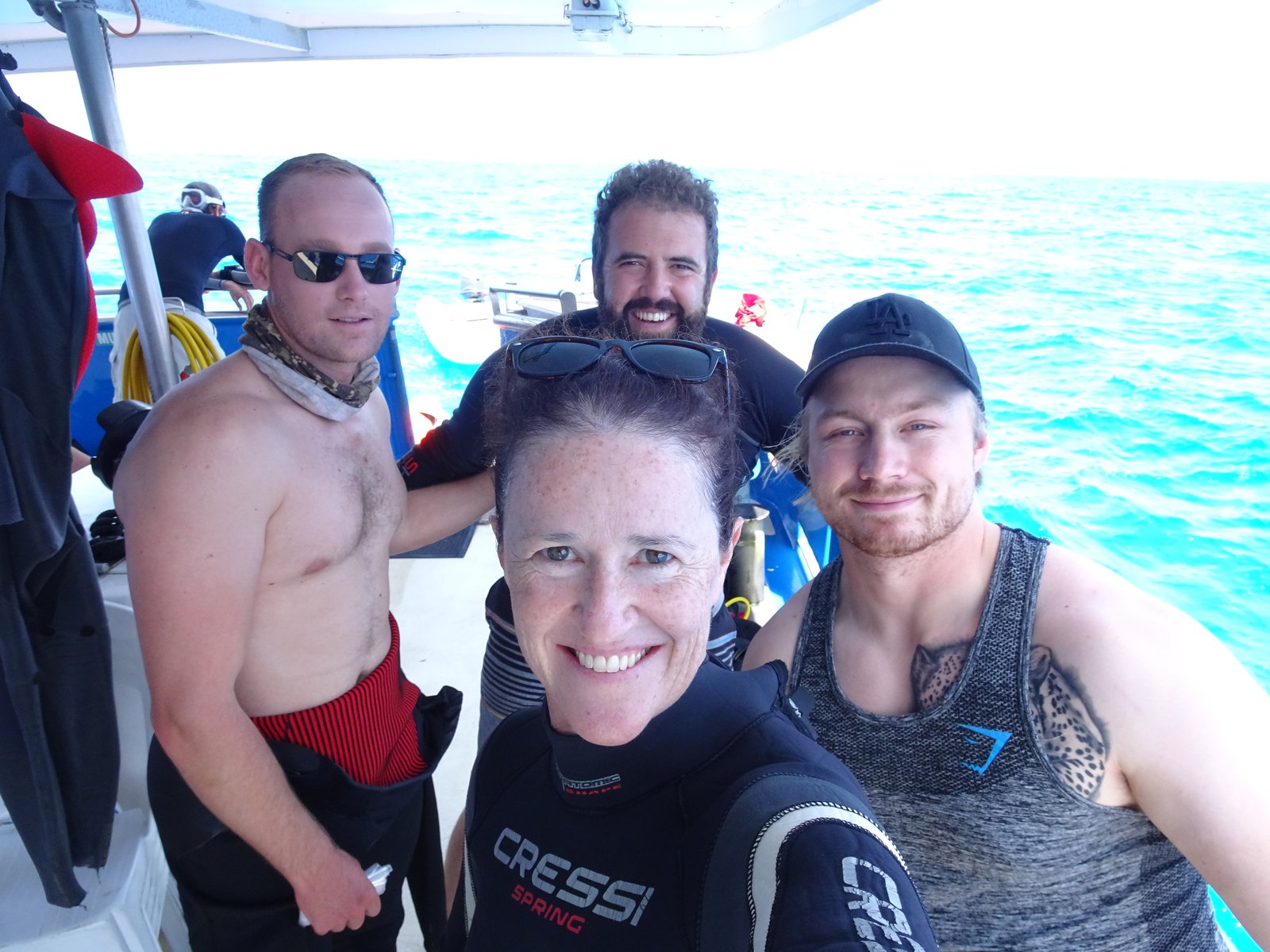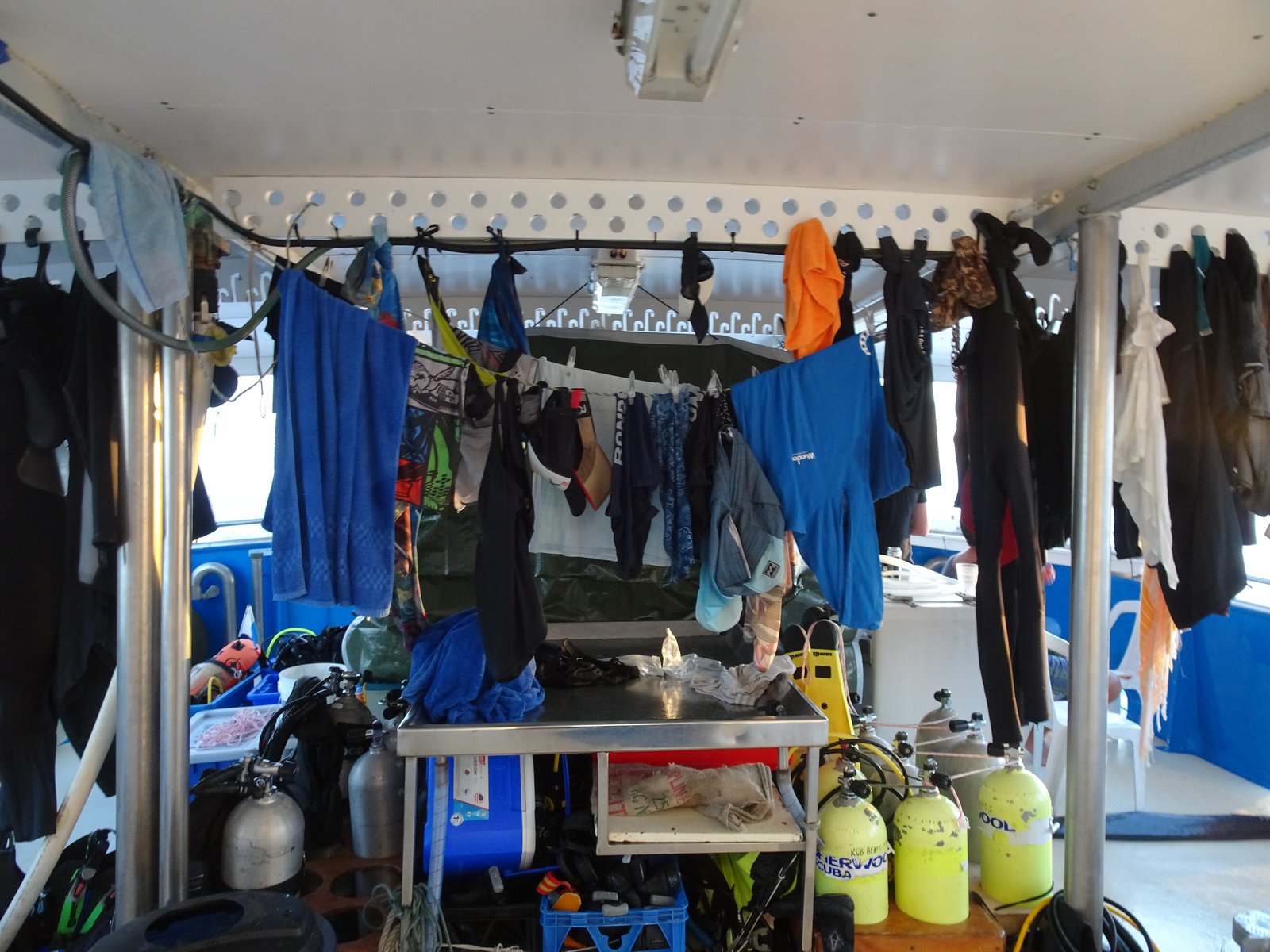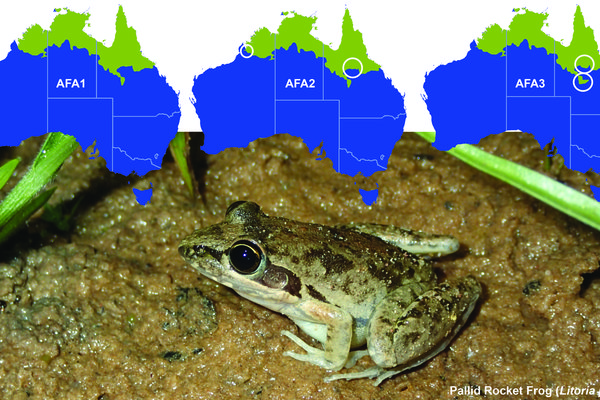Dots on the map of the Coral Sea
Dr Penny Berents and Amanda Hay recently embarked on a Coral Sea Voyage through the Coral Sea Marine Park. Read more about their discoveries aboard the Iron Joy!
I pulled on my mask, put my scuba regulator in my mouth and rolled backwards out of the rubber dinghy into warm, blue, clear water. Our trusty boatman, Cohen, passed me my bag of collecting equipment and I swam to the reef below with my teammates, Chris and Renato. On the reef beneath us, I could see other teams of scientists swimming along their transect tape surveying corals and fishes.

The Iron Joy.
Image: Amanda Hay© Australian Museum
Bougainville Reef, Osprey Reef, Willis Islets – these were dots on the map of the Coral Sea that had always intrigued me. I had wanted to dive these reefs for a long time. I found myself on board the Iron Joy in the Coral Sea Marine Park, studying these reefs with a team of scientists from the ARC Centre of Excellence for Coral Reef Studies at James Cook University (JCU), Parks Australia, the University of Sydney, the University of Queensland, the University of New England and the Australian Institute of Marine Science (AIMS).
Many people have had the pleasure of visiting the reefs of the Great Barrier Reef Marine Park (GBR) to snorkel, dive, or fish but few realise that way beyond the GBR is another huge marine park. The Coral Sea Marine Park covers an area of 989,836 km2 with 34 coral reefs and 56 cays and islets, which extends from 60 km to 1100 km from the Queensland coastline. The Coral Sea Marine Park is established under the EPBC Act (Environmental Protection and Biodiversity Conservation Act 1999) and is managed by the Director of National Parks Australia guided by the Coral Sea Management Plan 2018.

Coral Sea Marine Park map showing zones (Figure 3.1), from Director of National Parks 2018, Coral Sea Marine Park Management Plan 2018, Director of National Parks, Canberra.
Image: Australian Marine Parks© Australian Marine Parks
Amanda Hay (Ichthyology Collection Manager, AMRI) and I were participating in a survey of reefs in the Coral Sea on the Iron Joy. Amanda joined the first leg of the survey in Gladstone and visited Marion Reef and Saumarez Reef which are ancient reefs on the Marion Plateau, dating back to the Pliocene. Amanda’s trip also visited Cato Reef, Wreck Reef and Kenn Reefs which are parts of the Tasmantid Seamount Chain; these reefs rise up more than 1000 m to break the surface.
Leg 1 finished in Townsville with a changeover of some of the scientific crew and where the Iron Joy took on provisions and carried out minor repairs ready for leg 2 of the survey. I joined the vessel for leg 2 to survey reefs of the Queensland Plateau, a broad limestone plateau of reefs beyond the continental shelf. The survey visited Flinders Reefs, Heralds Cays, Chilcott Reefs, East Diamond Reef, Lihou Reefs, Willis Islets, Holmes Reef, Bougainville Reef and Osprey Reef.

Dr Penny Berents on the Iron Joy.
Image: David Logan© Parks Australia

Dr Penny Berents on the Iron Joy.
Image: Renato Morais© Renato Morais

Sterling Tebbett, Dr Christopher Goatley, Eoghan Aston and Amanda Hay, getting ready for a dive on the Iron Joy.
Image: Amanda Hay© Australian Museum
Life on the Iron Joy fell into a rhythm of diving, eating, entering data, processing samples and sleeping. With our first dive at 7 am, everybody scurried around after breakfast to get dive gear and equipment ready to jump into our tenders and head to the dive site. After the first dive we returned to the Iron Joy to fill scuba tanks and for a very welcome morning tea and coffee. The day was filled with more dives, data and eating. At meal times there was a rapid clearing of computers to enjoy a meal together. Shortly after eating, the tables were again crowded with computers for data entry or occasionally a game of cards before falling into bed.

Life on the Iron Joy.
Image: Amanda Hay© Australian Museum

Dr Christopher Goatley, Sterling Tebbett and Amanda Hay sorting, identifying and recording fishes on the Iron Joy.
Image: Amanda Hay© Australian Museum
Coral reefs typically evoke images of brightly coloured little fish, darting in and out of coral branches – but there is another world of other little fish living in those coral outcrops. Hidden in every crack and crevice of the reef is a poorly known community of small fishes, such as gobies, blennies, dottybacks and triplefins, and invertebrates such as shrimps, crabs, brittle stars and worms. Recent work (Brandl et al., 2018) has highlighted the diversity and abundance of this community of fishes which is known as cryptobenthic reef fishes (CRFs). Amanda and I worked with Dr Chris Goatley (UNE and Research Associate, AMRI) and Renato Morais (JCU) to study the community of CRFs and invertebrates. This cryptic community is likely to be a critical component of coral reef food chains and will no doubt reveal many species of fishes and invertebrates that are new to science.

Collage of fishes found during voyage, all under 50 mm.
Image: Christopher Goatley© Christopher Goatley
We collected the CRFs and cryptic invertebrates by enclosing a 4m2 outcrop of reef with a dome shaped weighted net. Animals hidden in the outcrop of reef were anaesthetised by a solution of clove oil, which was released into the enclosure. As the anaesthetic took effect the animals emerged from their hiding places in the reef and were trapped under the net and collected. Many of the animals were tiny and we used forceps to place them in plastic bags. On return to the Iron Joy the specimens were sorted, photographed and the data recorded for later upload to the AM collection database. All the specimens will be added to the AM collections and are preserved for current and future research.

Crabs, shrimps and brittle stars collected at Willis Islets.
Image: Penny Berents© Australian Museum
Amanda and I spent a total of 24 days at sea, performed 43 dives and spent about 50 hours underwater. We sampled 70 collecting stations and travelled thousands of kilometres in the Iron Joy. The specimens which we collected will take many months to sort and identify but will add to our knowledge of these remote reefs. The Australian Museum has very few specimens from the reefs of the Coral Sea. A few crabs and other invertebrates were collected from the Heralds Cays in the 1960s, however, none of the specimens is suitable for DNA analysis. The specimens will feed into current initiatives by Dr Joey DiBattista (Scientific Officer–Curator, Ichthyology, AMRI) and other AMRI scientists to sample, identify and obtain DNA tissues from fauna in Eastern Australia.

Sampling the hidden fauna on the reef.
Image: Amanda Hay© Australian Museum

Sampling the hidden fauna on the reef.
Image: Amanda Hay© Australian Museum
Dr Penny Berents, Senior Fellow, Marine Invertebrates, Australian Museum Research Institute.
REFERENCES
Brandl SJ, Goatley CHR, Bellwood DR, Tornabene L., 2018. The hidden half: ecology and evolution of cryptobenthic fishes on coral reefs. Biological Reviews of the Cambridge Philosophical Society 93(4):1846-1873. doi: 10.1111/brv.12423. Epub 2018 May 7.
Director of National Parks 2018. Coral Sea Marine Park Management Plan 2018, Director of National Parks, Canberra. https://parksaustralia.gov.au/marine/parks/coral-sea/plans/.
Acknowledgements
- This research was jointly funded by the Australian Museum Foundation, the Patricia Porritt Collection Acquisition Fund, and the Director of National Parks Australia.
- I would like to thank colleagues from the ARC Centre of Excellence for Coral Reef Studies at James Cook University for the opportunity to join this voyage.
- I would like to thank the Iron Joy crew and the scientific team who worked together so well and in good spirits to make the trip such a success.
- This research was conducted in the Coral Sea Marine Park under permit number PA2019-00123-1, issued by the Director of National Parks, Australia. The views expressed in this publication do not necessarily represent the views of Parks Australia, the Director of National Parks or the Australian Government.













